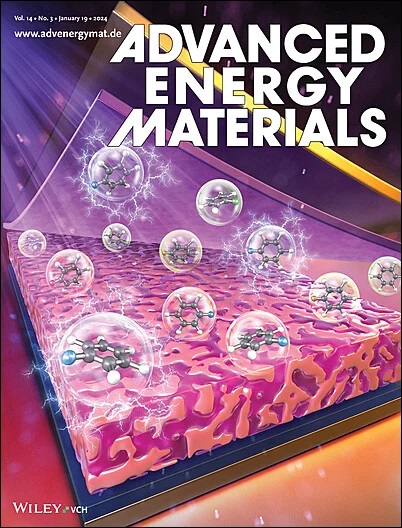The Elastic Covalent Polycysteine Crosslinked Binary Hollow FeS2 Nanospheres for Highly Reversible Sodium Storage
IF 24.4
1区 材料科学
Q1 CHEMISTRY, PHYSICAL
引用次数: 0
Abstract
The high irreversibility to FeS2-based anode thwarts its applicability in sodium ion batteries (SIBs), originally stem from the sluggish Na+ insertion/extraction kinetics, confined by the high desolvation barrier, the thick electric double layer (EDL) and the long transport routine inside FeS2. Herein, the covalent polypeptide oligomers (Pcy) based on cysteine (Cy) with β-sheet configuration grafted binary hollow carbon coupled FeS2@Fe2O3 heterostructure, i.e., FeS2/Fe2O3@C@Pcy, are designed to achieve low desolvation barrier, the contracted EDL via weakened coulombic interaction stems from the zwitterionic feature and enhanced Na+ transport capacity inside FeS2. The semi-interpenetrating oligomers possessing a weak coordination environment, massively accelerate the desolvation kinetics, additionally, the orderly and dense vertical occupation within the inner Helmholtz plane (IHP) also enormously reduces thickness of EDL. The binary hollow structure complex possessing typical ion looping routine considerably expedites the Na+ transport kinetics inside anode. Both experimental and theoretical trials demonstrate such FeS2 composite manifests a high reversibility in Na+ storage in virtue of exceptional structure stability, rapid ion transport kinetics, and swift reaction kinetics.

求助全文
约1分钟内获得全文
求助全文
来源期刊

Advanced Energy Materials
CHEMISTRY, PHYSICAL-ENERGY & FUELS
CiteScore
41.90
自引率
4.00%
发文量
889
审稿时长
1.4 months
期刊介绍:
Established in 2011, Advanced Energy Materials is an international, interdisciplinary, English-language journal that focuses on materials used in energy harvesting, conversion, and storage. It is regarded as a top-quality journal alongside Advanced Materials, Advanced Functional Materials, and Small.
With a 2022 Impact Factor of 27.8, Advanced Energy Materials is considered a prime source for the best energy-related research. The journal covers a wide range of topics in energy-related research, including organic and inorganic photovoltaics, batteries and supercapacitors, fuel cells, hydrogen generation and storage, thermoelectrics, water splitting and photocatalysis, solar fuels and thermosolar power, magnetocalorics, and piezoelectronics.
The readership of Advanced Energy Materials includes materials scientists, chemists, physicists, and engineers in both academia and industry. The journal is indexed in various databases and collections, such as Advanced Technologies & Aerospace Database, FIZ Karlsruhe, INSPEC (IET), Science Citation Index Expanded, Technology Collection, and Web of Science, among others.
 求助内容:
求助内容: 应助结果提醒方式:
应助结果提醒方式:


